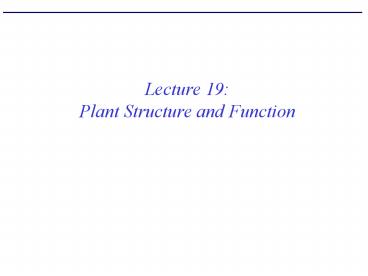Lecture 19: Plant Structure and Function - PowerPoint PPT Presentation
1 / 24
Title:
Lecture 19: Plant Structure and Function
Description:
Roots are often covered with root hairs which increase the surface area ... apical meristems -- results in increase in length of ... at apical meristems ... – PowerPoint PPT presentation
Number of Views:95
Avg rating:3.0/5.0
Title: Lecture 19: Plant Structure and Function
1
Lecture 19Plant Structure and Function
2
Plant structure can be divided into two systems
roots and shoots
3
The Root System
- Parts under ground
- Used for anchorage
- Used for absorption of water and nutrients
Tap root
Fibrous root
4
Roots are often covered with root hairs which
increase the surface area for absorption
Epidermal cell
Root hair
5
Modified roots
6
The Shoot System
- Stems, leaves, buds
- Nodes are places on the stem where leaves are
attached and buds form.
7
Figure 35.5 Simple versus compound leaves
8
Figure 35.19 Leaf anatomy
9
Figure 35.6 Modified leaves Tendrils, pea plant
(top left) spines, cacti (top right) succulent
(bottom left) brightly-colored leaves,
poinsettia (bottom right)
10
Figure 35.4 Modified shoots Stolons, strawberry
(top left) rhizomes, iris (top right) tubers,
potato (bottom left) bulb, onion (bottom right)
11
Plant structures are composed of 3 types of
tissues
- ground tissue -- bulk of plant body
- vascular tissue -- distribution of water and
solutes - dermal tissue -- covering, protection of plant
surface.
12
Vascular tissue xylem and phloem
13
Plant growth occurs at localized regions called
meristems
- Meristem cells are undifferentiated and can
divide through mitosis - Continued divisions of meristem cells keeps a
plant growing throughout it's life
indeterminate growth. - apical meristems -- results in increase in length
of stems and roots - lateral meristems -- growth produces thickening
of stems and roots
14
Growth at apical meristems primary growth
- As a stem or root grows, primary meristems
develop behind the growing tip - These differentiate into the three tissue
systems - Dermal tissue comes from
- protoderm --gt epidermis (waxy covering in shoots)
- Vascular tissue comes from
- procambium --gt vascular cambium--gt primary xylem
and phloem - Ground tissue comes from
- ground meristem -gt ground tissues--gt cork cambium
15
Figure 35.17 The terminal bud and primary growth
of a shoot
16
Growth at lateral meristems Secondary growth
- In woody plants vascular cambium forms a ring
- each growing season a new layer of xylem is
produced which pushes the cambium and all outer
tissues further out. - Old phloem cells are crushed and only a thin
strip of newly- formed phloem remains alive.
17
Figure 35.22 Anatomy of a three-year-old stem
18
Figure 35.23 Anatomy of a tree trunk
- As the stem expands, it ruptures the epidermis
- Bark is composed of phloem and ground issue cells
called cork cells
19
Tree Girdling
20
If you hammer a nail into a tree 10 feet above
the ground, and wait 20 years, where will the
nail be?
?
10 feet
21
Angiosperms are often divided into the monocots
and dicots
22
(No Transcript)
23
Monocots
24
Dicots

